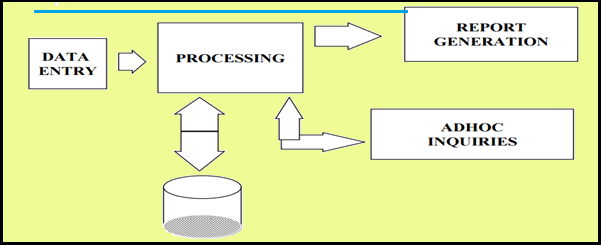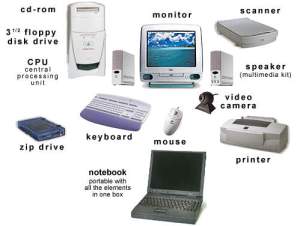Six Major Types of Information Systems
Six Major Types of Information Systems
A typical organization has six of information systems with each supporting a specific organizational level. These systems include transaction processing systems (TPS) at the operational level, office automation systems (OAS) and knowledge work systems (KWS) at the knowledge level, management information systems (MIS) and decision support Systems (DSS) at the management level, and the executive support systems (ESS)at the strategic level.
Transaction Processing Systems
Every firm needs to process transactions in order to perform their daily business operations. A transaction refers to any event or activity that affects the organization. Depending on the organization’s business, transactions may differ from one organization to another. In a manufacturing unit, for example, transactions include order entry, receipt of goods, shipping, etc., while in a bank, transactions include deposits and withdrawals, cashing of cheques etc.
However, some transactions, including placing orders, billing customers, hiring employees, employee record keeping, etc., are common to all organizations. To support the processing of business transactions, the transaction processing systems (TPS) are used in the organizations.

There are Five Stages of Transaction Processing
- Data Entry
- Processing
- Database Maintenance
- Document And Report Generation
- Inquiry Processing

Office Automation Systems
An office automation system (OAS) is a collection of communication technology, computers and persons to perform official tasks. It executes office transactions and supports official activities at every organizational level. These activities can be divided into clerical and managerial activities.
Clerical activities performed with the help of office automation system include preparing written communication, typesetting, printing, mailing, scheduling meetings, calendar keeping.etc. Under managerial activities, office automation system helps in conferencing, creating reports and messages, and controlling performance of organization. Many applications like word processing, electronic filing and e-mail are integrated in office automation system.
Word Processing
Word processing is used for the preparation of documents like letters, reports, memos, or any type of printable material by electronic means. The text is entered by keyboard and displayed on the computer’s display unit. This text can be edited, stored, and reproduced with the help of commands present in the word processor. Word processors have facilities for spell checking, grammar checking, counting (character,lines, pages, etc.), automatic page numbering, index creation, header and footer,etc.
Email
E-mail or electronic mail facilitates the transfer of messages or documents with the help of computer and communication lines. This helps in speedy delivery of mails and also reduces time and cost of sending a paper mail. E-mail supports not only the transfer of text messages but it also has options for sending images,audio, video, and many other types of data.
Voice Mail
Voice mail, an important call service, allows recording and storing of telephone messages into the computer’s memory. The intended person can retrieve these messages any time.
Knowledge Work Systems
(data->Information->Knowledge->Wisdom)
Knowledge puts information into ease of use.
Wisdom : documenting the knowledge, sharing and teaching the same to peers and others leads to wisdom (application awareness)
Call the fireman if the neighbor's house on fire and call the doctor if you're ill.
A knowledge work system (KWS) is a specialized system built to promote the creation of knowledge and to make sure that knowledge and technical skills are proper integrated into business. It helps the knowledge workers in creating and propagating new information and knowledge by providing them the graphics, analytical, communications, and document management tools.
The knowledge workers also need to search for knowledge outside the organization. Thus, knowledge work system must give easy access to external databases. In addition, knowledge work systems should have user-friendly interface to help users to get the required information quickly and easily.
Some examples of knowledge work systems are computer-aided design (CAD)systems, virtual reality systems, and financial workstations.
Computer-aided design (CAD) systems: These systems are used for automating the creation and revision of designs using computers and graphics software. The CAD software has the capability to provide design specifications for tooling and manufacturing process. This saves much time and money while making a manufacturing process.
Virtual Reality System: These systems have more capabilities than CAD systems for visualization, rendering and simulation. They make use of interactive graphics software to build computer-generated simulations which almost look like real. They can be used in educational, scientific and business work.
Financial Workstations: They are used to combine a wide range of data from internal as well as external sources. This data includes contact management data, market data and research reports. Financial workstations help in analyzing trading situations and large amount of financial data within no time. It is also used for portfolio management.
Management Information Systems
Management information systems are especially developed to support planning, controlling, and decision-making functions of middle managers. A management information system (MIS) extracts transaction data from underlying TPSs, compiles them, and produces information products in the form of reports, displays or responses.
These information products provide information that conforms to decision-making needs of managers and supervisors. Management information systems use simple routines like summaries and comparisons which enable managers to take decisions for which the procedure of reaching at a solution has been specified in advance.
Generally, the format of reports produced by MIS is pre-specified. A typical MIS report is a summary report, such as a report on the quarterly sales made by each sales representative of the organization. Another type of management information system report is an; for example, exception report that specifies the exception conditions the sales made by some sales representative is far below than expected.
Usually, management information systems are used to produce reports on monthly, quarterly, or yearly basis. However, if managers want to view the daily or hourly data, MIS enables them to do so. In addition, they provide managers online access to the current performance as well as past records of the organization.
Decision Support Systems
A decision support system (DSS) is an interactive computer-based information system that, like MIS, also serves at the management level of an organization. However, in contrast to MIS, it processes information to support the decision making process of managers. It provides middle managers with the information that enables them to make intelligent decisions. A decision support system in a bank, for example, enable a manager to analyze the changing trends in deposits and loans in order to ascertain the yearly targets.
Decision support systems are designed for every manager to execute a specific managerial task or problem. Generally, they help managers to make semi-structured decisions, the solution to which can be arrived at logically. However, sometimes, they can also help in taking complex decisions. To support such decisions, they use information generated by OASs and TPSs.
Decision support systems have more analytical power as compared to other information systems. They employ a wide variety of decision models to analyze data or summarize vast amount of data into a form (usually form of tables or charts) that make the comparison and analysis of data easier for managers. They provide interactive environment so that the users could work with them directly, add or change data as per their requirements, and ask new questions.
Executive Support Systems
An executive support system (ESS) – an extension of MIS – is a computer based information system that helps ind decision making at the top-level of an organization. The decisions taken with the help of executive support system are non-routine decisions that effect the entire organization and, thus, require judgement and sight.
As compared to DSSs, ESSs offer more general computing capabilities, better telecommunications and efficient display options. They use the advanced graphics software to display the critical information in the form of charts or graphs that help senior executives to solve a wide range of problems. To make effective decisions, they use summarized internal data from MIS and DSS as well as data from external sources about events like new tax laws, new competitors, etc. They filter, compress, and track data of high importance and make it available to the strategic-level managers.
Executive support systems help to monitor performance, track activities of competitors, identify opportunities, and forecast trends. They also assist senior managers in answering the following question:
• What business should we do?
• How are our competitors doing the business?
• Which units can be sold and which new units are to be bought?
Following are the important differences between MIS and DSS.
The main difference between management information system and decision support system is that the management information system (MIS) supports structured decision making while the decision support system (DSS) provides support for unstructured or semi-structured decisions. ... It mainly supports structured decision making.
| Sr. No. | Key | MIS | DSS |
|---|---|---|---|
| 1 | Primary Task | MIS identifies the information required. | DSS identifies the tools to be used in decision process. |
| 2 | Focus | Focus is on efficiency. | Focus is on effectiveness. |
| 3 | Database | Corporate Databases are used. | Special Database needed. |
| 4 | Data | Focus is on data storage. | Focus is on data manipulation. |
| 5 | Dependency | Dependent on computer. | Dependent on management juridiction. |
| 6 | Usage | MIS is used to in control process. | DSS is used in planning, staffing and decision making. |
| 7 | Users | MIS is used by middle level, low level users and senior executives in some cases. | DSS is used by analysts, professionals and managers. |
| 8 | Focus | Focus is on information processing. | Focus is on decision making, support and analysis. |
What is COMPUTER BASED INFORMATION SYSTEM (CBIS) ?
Computer(-Based) Information System is essentially an IS using computer technology to carry out some or all of its planned tasks. The basic components of computer based information system are:
- Hardware– these are the devices like the monitor, processor, printer and keyboard, all of which work together to accept, process, show data and information.

- Software– are the programs that allow the hardware to process the data.
- Databases– are the gathering of associated files or tables containing related data.
- Networks– are a connecting system that allows diverse computers to distribute resources.
- Procedures– are the commands for combining the components above to process information and produce the preferred output.






This comment has been removed by the author.
ReplyDeleteThanks for this advise !! bing coupon
ReplyDelete